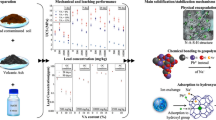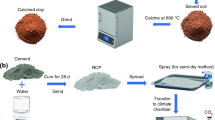Abstract
The hypothesis tested was that macroscopic swelling of montmorillonitic clays is reduced by the presence of interlayer minerals. Fine and coarse clay fractions of Camargo and Panther Greek bentonite samples were artificially interlayered by reaction of A12(SO4)3 and NaOH in 0∙5% suspensions of the clays. All four clay fractions reacted similarly to artificial interlayering. At an Al:clay ratio of 16 meq Al/g clay the CEC was completely lost, surface area was reduced and X-ray basal spacings were altered. No macroscopic swelling occurred in samples treated with 16 meq of Al/g of clay. At smaller concentrations of hydroxy-aluminum 8 and 2 meq Al/g clay, the clay properties were less drastically altered. Extraction of interlayered clays with Na citrate restored the original C.E.C., surface area, and basal spacings of all samples and resulted in some slight enhancement of C.E.C. and surface areas of the coarse fractions. Treatment with hot Na citrate resulted in an increase in swelling ability but only slight increases in C.E.C. and surface area. Evidence presented supports the hypothesis that macroscopic swelling of montmorillonitic clays is greatly reduced by interlayer materials. Reduced swelling due to interlayering occurs even when other clay properties may be slightly different from those of nontreated samples. Indications are that interlayer material occurs naturally in the clays studied and this may apply to other bentonite deposits.
Résumé
L’hypothèse soumise à vérification était que le gonflement macroscopique des argiles mont-morillonitiques est réduit par la présence de minéraux interfeuillets. Des fractions argileuses fixes et grossières d’échantillons de bentonite de Camargo et Panther Creek ont eu leurs espaces interfeuillets artificiellement remplis en faisant réagir Al2(SO4)3 et NaOH dans des suspensions d’argile à 0,5%. Les quatre fractions argileuses ont réagi de la même manière au cours de ce traitement. Pour un rapport Al/argile de 16 me Al par g d’argile, la C.E.C. disparaît complètement, la surface est réduite et les distances basales déterminées aux rayons X sont modifiées. Aucun gonflement macroscopique n’est observable avec les échantillons traites avec 16 me Al par g d’argile. A des concentrations d’hydroxy-aluminium plus basses, 8 et 2 me Al par g d’argile, les propriétés de l’argile sont altérées moins profondément. Lorsqu’on extrait par le citrate de sodium les argiles traitées, on observe pour tous les échantillons le retour aux valeurs d’origine de la C.E.C., de la surface et des distances basales, en aboutissant même à une légère augmentation de la C.E.C. et de la surface des fractions grossières. Le traitement avec le citrate de sodium chaud entraîne une augmentation de l’aptitude au gonflement, mais seulement un faible accroissement de la C.E.C. et de la surface. Cette observation confirme donc l’hypothèse selon laquelle le gonflement macroscopique des argiles montmorillonitiques est fortement réduit par les matériaux interfeuillets. Cette réduction du gonflement due à certaines insertions interfeuillets s’observe même quand d’autres propriétés de l’argile ne sont que légèrement différentes de celles des échantillons non traités. Il y a des indications pour penser que certains matériaux interfeuillets sont présents naturellement dans les argiles étudiées, ce qui peut s’appliquer à d’autres dépôts de bentonite.
Kurzreferat
Es wurde die Hypothese untersucht wonach makroskopische Quellung montmorillonitischer Tone in der Gegenwart von Zwischenschichtmineralem vermindert wird. Feine und grobe Tonfraktionen aus Camargo und Panther Creek Bentonit Proben wurden künstlich durch die Reaktion von Al2(SO4)3 und NaOH in 0,5% Suspensionen der Tone mit Zwischenlagerung versehen. Alle vier Tonfraktionen reagierten ähnlich zur künstlichen Zwischenlagerung. Bei einem Al:Ton Verhältnis von 16 meq Al/g Ton ging die Kationenaustauschkapazität (C.E.C.) vollkommen vorloren, die Oberfläche wurde vermindert und die Röntgen Basiszwischenräume wurden verändert. In Proben, die mit 16 meq Al/g Ton behandelt wurden trat keine makroskopische Quellung auf. Bei kleineren Konzentrationen von Hydroxy — Aluminium 8 und 2 meq Al/g Ton, waren die Eigenschaften des Tones weniger drastisch verändert. Extraktion von zwischengelagerten Tonen mit Na-Citrat stellte die ursprüngliche C.E.C., Oberflächeninhalt und Basiszwischenräume von allen Proben wieder her und ergab in manchen eine Leichte Zunahme der C.E.C. und der Oberflächeninhalte der groben Fraktionen. Behandlung mit heissem Na-Citrat ergab eine Zunahme in Quellfähigkeit jedoch eine geringe Zunahmen in C.E.C und Oberfläche. Das vorgelegte Beweismaterial stützt die Hypothese wonach makroskopische Quellung montmorillonitischer Tone durch-zwischenlagerstoffe weitgehend vermindert wird. Verminderte Quellung infolge von Zwischenlagerung erfolgt sogar wenn die anderen Toneigenschaften etwas verschieden von denen der unbehandelten Proben sind. Es bestehen Anzeichen dafür, dass Zwischenlagerungsstoffe in den untersuchten Tonen natürlich vorkommen und das mag auch bei anderen Bentonitablagerungen der Fall sein.
Резюме
Проверены предположения об уменьшении макроскопического разбухания монтмо-риллонитовых глин при наличии межслоевых минералов. Межслоевые промежутки тонких и грубых глинистых фракций бентонитовых образцов из Камарго и Пантер Крик искусственно насыщались в результате реакции А12(SO4)з и NaОН в 0,5% суспензиях глин. Все четыре глинистые фракции вели себя одинаково при образовании смешанно-слойных фаз. При соотношении А1 и глины, равном 16 м — экв А1/г глины способность к обмену катионов была полностью утрачена, площадь поверхности уменьшилась и базальные межплоскостные расстояния (по рентгеновским данным) изменились. Макроскопическое разбухание не происходило в образцах, обработанных 16 м — экв А1/г глины. При меньших концентрациях гидроокиси алюминия (8 и 2 м — экв А1/г глины) глинистые свойства не были изменены столь резко. Обработка смешанно-слойных глин лимоннокислым Na восстанавливала первоначальную способность к обмену катионов, площадь поверхности, базальные межслоевые расстояния всех образцов и приводила к некоторому увеличению катионного обмена и площади поверхности грубых фракций. Обработка горячим цитратом Nа приводила к увеличению способности к разбуханию и только к незначительному увеличению способности к обмену катионов и площади поверхности. Полученные данные подтверждают гипотезу о значительном снижении разбухания монтмориллонитовых глин с межслоевым материалом. Уменьшение разбухания благодаря присутствию межслоевого материала происходит даже тогда, когда другие глинистые свойства могут только незначительно отличатся от такоых необработанных образцов. Установлено, что в изученных глинах встречается смешанно-слойный материал; это же может быть и в других бентонитовых месторождениях.
Similar content being viewed by others
References
Bolt, G. H. (1956) Physico-chemical analyses of the compressibility of pure clays: Geotechniques. 6, 86–93.
Carstea, D. D., Harward, M. E. and Knox, E. G. (1970) Formation and stability of hydroxy-Mg interlayers in phylosilicates: Clays and Clay Minerals 18, 213–222.
Carter, D. L., Heilman, M. D. and Gonzalez, C. L. (1965) Ethylene glycol monoethyl ether for determining surface area of silicate minerals: Soil Sci. 100, 356–360.
Davey, B. G. and Low, P. F. (1968) Clay-water interaction as affected by hydrous aluminum oxide films: 9th. Int. Congr. Soil Sci. Transactions. 1, 607–616.
Fink, D. H., Rich, C. I. and Thomas, G. W. (1968) Determination of internal surface area, external water and amount of montmorillonite in clay-water systems: Soil Sci. 105, 71–77.
Frink, C. R. (1964) The effects of wash solvents on cation exchange capacity measurements: Soil Sci. Soc. Am. Froc. 28, 506–511.
Frink, C. R. (1965) Characterization of aluminum interlayers in soil clays: Soil Sci. Soc.Am.Proc. 29, 379–382.
Jackson, M. L. (1956) Soil chemical analysis—advanced course. Published by the author. Madison, Wisconsin.
Jones, E. C. and Roberson, H. E. (1966) Structural charge density as indicated by montmorillonite hydration: Clays and Clay Minerals. 13, 223–230.
Low, P. F. (1968) Mineralogical data requirements in soil physical investigations, pp. 1–34, Special Publ. No. 3. Mineralogy in Soil Sciences and Engineering. Soil Sci. Soc. Am., Madison, Wisconsin.
Mungan, N. and Jessen, F. W. (1963) Studies in fractionated montmorillonite suspensions: Clays and Clay Minerals 10, 282–294.
Rich, C. I. (1960) Aluminum in interlayers of vermiculite: Soil Sci. Soc. Am. Proc. 24, 26–32.
Rich, C. I. (1968) Hydroxy interlayers in expansible layer silicates: Clays and Clay Minerals 16, 15–30.
Rollins, M. B. and Pool, D. L. (1968) Measurement of exchangeable cations in bentonites: Clays and Clay Minerals 16, 165–172.
Rowell, D. L. (1963) Effect of electrolyte concentration on the swelling of oriented aggregates of montmorillonite: Soil Sci. 96, 368–374.
Rowell, D. L. (1965) Influence of positive charge on the inter- and intra-crystalline swelling of oriented aggregates of Na-montmorillonite in NaCl suspensions. Soil Sci. 100, 340–347.
Sawhney, B. L. (1960) Aluminum interlayers in clay minerals: 7th. Int. Congr. of Soil Sci. Transactions. 4, 476–481.
Schwertmann, U. and Jackson, M. L. (1964) Influence of hydroxy-aluminum ions on pH titration curves of hydronium-aluminum clays: Soil Sci. Soc. Am. Proc. 28, 179–183.
Van Olphen, H. (1964) An introduction to clay colloid chemistry. Interscience, New York.
Warkentin, B. P., Bolt, G. H. and Miller, R. D. (1957) Swelling pressure of montmorillonite: Soil Sci. Soc. Am. Proc. 21, 495–497.
Warkentin, B. P. and Schofield, R. K. (1962) Swelling pressure of Na-montmorillonite in NaCl solutions. J. Soil Sci. 13, 98–105.
Weismiller, R. A., Ahlrichs, J. L. and White, J. L. (1967) Infrared studies of hydroxy-aluminum interlayer material: Soil Sci. Soc. Am. Proc. 31, 459–463.
Author information
Authors and Affiliations
Additional information
Published with approval of the director as paper No. 2225 of the Journal Series.
Rights and permissions
About this article
Cite this article
Kidder, G., Reed, L.W. Swelling Characteristics of Hydroxy-Aluminum Interlayered Clays. Clays Clay Miner. 20, 13–20 (1972). https://doi.org/10.1346/CCMN.1972.0200103
Received:
Published:
Issue Date:
DOI: https://doi.org/10.1346/CCMN.1972.0200103




